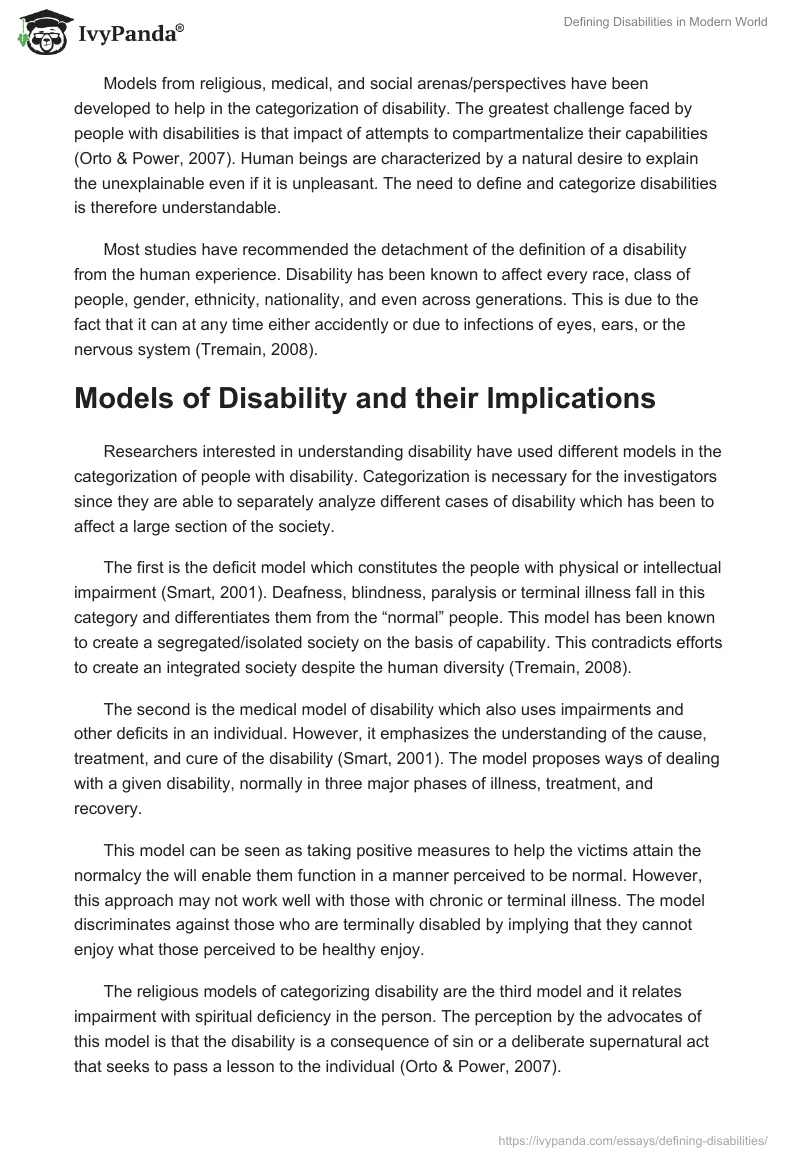Introduction
Human beings experience different challenges when interacting with their environment especially when they have personal obstacles. A past report by the U. S. Census Bureau categorized about 19% of the American population as having some degree of either physical or intellectual disability (Smart, 2001). Defining disability has not been easy due to the various opinions related to the understanding of the concept.
Disability has been defined in general terms as any impairment or a problem in normal body structure that may hinder the normal functioning of the body (Orto & Power, 2007). Some of the impairments identified include that of hearing, sight, cognitive, emotional and motor challenges. These categories of impairments are further divided into sub-categories. Impairments affecting sight include blurred vision, color blindness, and blindness.
World health Organization defines disability as a general term referring to impairments, limitation in the performance of activities, and restrictions when it comes to participating and interacting with the environment (Orto & Power, 2007). The paper discusses the various categories of disability and why it is important to define and categorize disabilities.
Definition
Disability has become a concern all over the world following the increasing awareness by the people. Definition of this concept has undergone significant transformation from the perspective of people with disabilities (PWDs) and the society at large. Disability has significant impact on the society due to the relationships that exists between the individual and the surrounding (Smart, 2001). Efforts to reduce ambiguity in the definition of disability have been made especially by western social-scientific researchers.
Models from religious, medical, and social arenas/perspectives have been developed to help in the categorization of disability. The greatest challenge faced by people with disabilities is that impact of attempts to compartmentalize their capabilities (Orto & Power, 2007). Human beings are characterized by a natural desire to explain the unexplainable even if it is unpleasant. The need to define and categorize disabilities is therefore understandable.
Most studies have recommended the detachment of the definition of a disability from the human experience. Disability has been known to affect every race, class of people, gender, ethnicity, nationality, and even across generations. This is due to the fact that it can at any time either accidently or due to infections of eyes, ears, or the nervous system (Tremain, 2008).
Models of Disability and their Implications
Researchers interested in understanding disability have used different models in the categorization of people with disability. Categorization is necessary for the investigators since they are able to separately analyze different cases of disability which has been to affect a large section of the society.
The first is the deficit model which constitutes the people with physical or intellectual impairment (Smart, 2001). Deafness, blindness, paralysis or terminal illness fall in this category and differentiates them from the “normal” people. This model has been known to create a segregated/isolated society on the basis of capability. This contradicts efforts to create an integrated society despite the human diversity (Tremain, 2008).
The second is the medical model of disability which also uses impairments and other deficits in an individual. However, it emphasizes the understanding of the cause, treatment, and cure of the disability (Smart, 2001). The model proposes ways of dealing with a given disability, normally in three major phases of illness, treatment, and recovery.
This model can be seen as taking positive measures to help the victims attain the normalcy the will enable them function in a manner perceived to be normal. However, this approach may not work well with those with chronic or terminal illness. The model discriminates against those who are terminally disabled by implying that they cannot enjoy what those perceived to be healthy enjoy.
The religious models of categorizing disability are the third model and it relates impairment with spiritual deficiency in the person. The perception by the advocates of this model is that the disability is a consequence of sin or a deliberate supernatural act that seeks to pass a lesson to the individual (Orto & Power, 2007).
They strive to offer a religious account of every disability as well as recommend ways of addressing the “problem”. Just like the medical model, the religious models do not go well with those with chronic illness since they just need a way of balancing their condition and facing life more positively. The two models utterly condemn this group of PWD by implying that their situations cannot be addressed otherwise.
The fourth is the social model of disability which tries to explain the various impairments. The proponents perceive disability to be a consequence of “natural” occurrence. Disability is seen as a construct of an oppressive society with an historical background (Smart, 2001).
People with disabilities have in the recent past raised their concerns about the stigmatization from the society leading to isolation and discrimination. This model, on the other hand, has been praised for challenging the trivialization of representations of PWDs by providing crucial historical backgrounds of disabilities.
Conclusion
The paper has explored in detail the definition of the complex concept of disability in the modern world. Various working definitions of disability as used by researchers have been highlighted. The conventional definition used by the World Health Organization has also been given.
The paper has also discussed the four major models used to categorize disabilities. The importance of each has been given. It can be concluded that the definition and categorization of disability faces great opposition, especially from the disabled and other activists and efforts to reach a mutual understanding of perceiving disability should be made.
References
Orto, E. A. & Power, P. W. (2007). The impact of disability: psychological and social. Springer Publishing Co.
Smart, J. (2001). Disability, society, and the individual (2nd ed). Aspen Publishers
Tremain, S. P. (2008). Understanding disability: post-modernity and models of disability (3rd ed). London: Continuum


